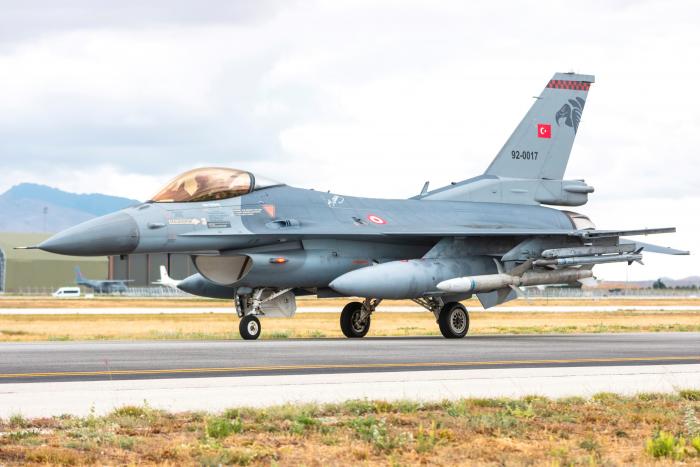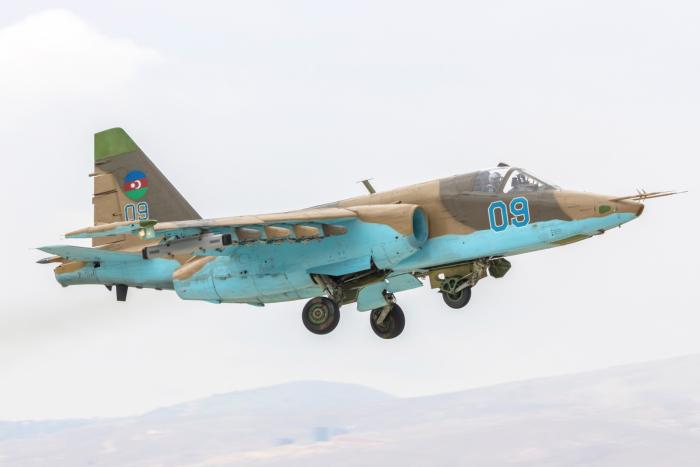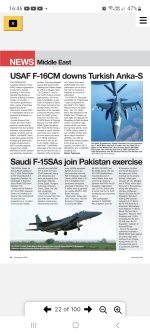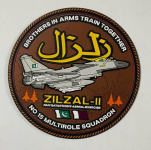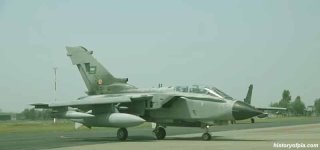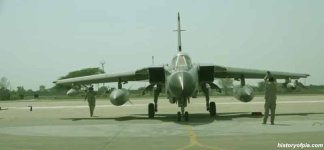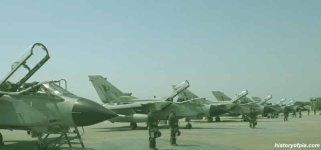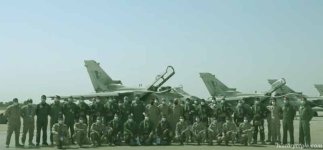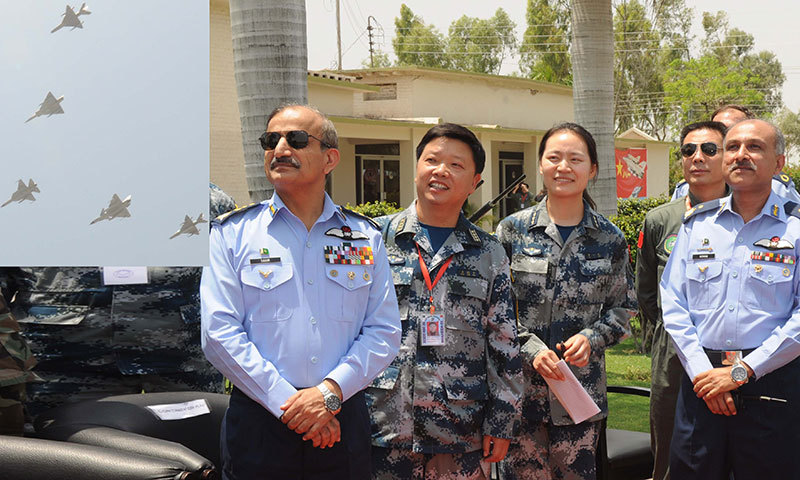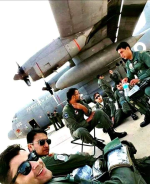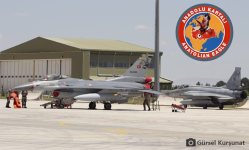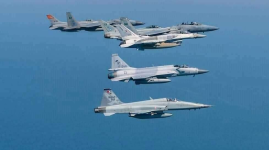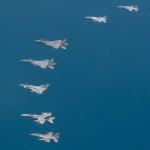Pak-China Joint Air Force Drills
Shaheen-III
By
Shazia Mehmood Khan
-
June 10, 2014
https://www.facebook.com/sharer.php.../2014/06/10/pak-china-joint-air-force-drills/
https://twitter.com/intent/tweet?te...a-joint-air-force-drills/&via=Defence+Journal
https://pinterest.com/pin/create/bu...&description=Pak-China+Joint+Air+Force+Drills
https://api.whatsapp.com/send?text=.../2014/06/10/pak-china-joint-air-force-drills/
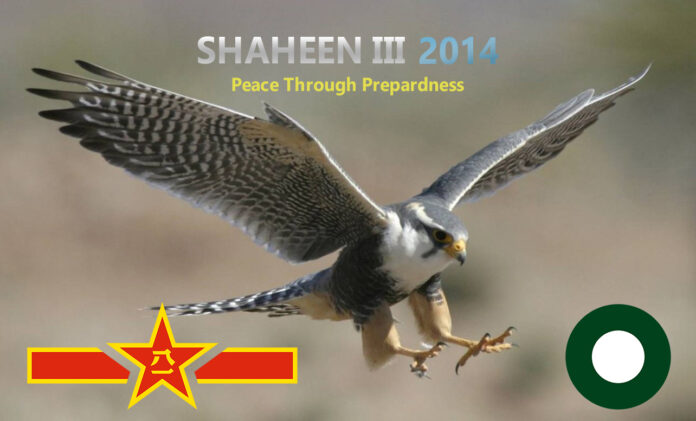
The Joint International Air Exercise “Shaheen-III” recently conducted between the Pakistan Air Force and People’s Liberation Army Air Force (PLAAF) culminated at an operational air base of the Pakistan Air Force. The air exercise was designed to further strengthen the existing exemplary bonds between the two air forces, learn modern air warfare mechanics and share operational thoughts among pilots, radar controllers and other team members.
PAF Regular Engagements
On its part, PAF regularly undertakes similar operational exercises both inland and abroad to remain abreast of challenges and response strategies faced by air power in changing threat environment. The exercise was a great advantage for both air forces, as Chinese pilots got a chance to fly against an adversary whose training and tactics were Western based and PAF got a chance to fly against a new type.
Deputy Chief of the Air Staff (Operations)
Deputy Chief of the Air Staff (Operations), Air Marshal Sohail Aman was the chief guest at the closing ceremony. During the Shaheen-III air exercise, PAF and PLAAF participated with modern fighter jets and support elements. Following the rich tradition of the PAF leadership to lead from the front, Air Marshal Sohail Aman also flew in an offensive strike mission package.
Importance of Shaheen-III
The three-week-long Shaheen-III air exercise was the third event of the Shaheen series of bilateral exercises between the two countries’ air forces. The exercise was intended to boost cooperation between China and Pakistan and was a source of valuable experience for pilots on both sides. The exercise was “multi-dimensional” and involved operations in “near real scenarios.”
PAF & PLAAF Contingents
A contingent of People’s Liberation Army Air Force (PLAAF) comprising combat pilots, air defence controllers and technical ground crew besides a Pakistan Air force (PAF) contingent participated in the exercises. The PLAAF used its Chengdu J-10 and J-7 combat aircraft while the PAF used its JF-17 Thunder, Mirage, and F7 PG fighters. “The Air Exercises between the two professional Air Forces would not only cement the already existing friendly bonds but would also give an opportunity to learn from each other’s combat experience,” said one PAF spokesperson during the exercises. Shaheen-III was the first exercise in the series to involve the PAF’s JF-17 Thunder.
Chinese’s Participation
China sent a six-member PLAAF delegation led by Major General Zhan Houshun to the closing ceremony of the exercise. General Zhan commands the Chengdu Regional Air Force Command and was a coordinating officer for the exercise. General Zhan lauded the PAF’s training and combat efficiency during the closing ceremony.
Major Houshun commented, “PAF has conducted joint exercises with foreign air forces for a long time, obtained great achievements, demonstrated first rate training level and combat efficiency and gained rich experiences from which rich lessons can be drawn. We are deeply impressed by PAF’s aggressive combat style and brave fighting spirit and greatly moved by the ‘train as you fight’ training principle and streamlined efficient training approach.”
“We admire your superb and all round flying skill and outstanding tactical expertise. We have learnt a lot from you which will bring a whole new inspiration to the innovation and development of PLAAF’s military training”. He further said, “I am sure that the closure of joint training is not an end but a new starting point which will deepen, broaden and promote the friendship, exchanges and cooperation between China and Pakistan, the two armed forces and specially the two Air Forces.
The Shaheen series of exercises began in 2011 and was originally designed to allow the air forces of China and Pakistan to cooperate more effectively. Shaheen-I took place in 2011 in Pakistan and Shaheen-II took place in 2013 in China. More broadly, the exercises are designed to cement military-to-military ties between the two countries which often describe their overall relationship as “all-weather” partners.
Air Chief Marshal Tahir Rafique’s Statement
Air Chief Marshal Tahir Rafique Butt, Chief of the Air Staff, Pakistan Air Force visited a PAF Base for witnessing the last phase of the Joint International Air Exercise “Shaheen-III” at an Operational Air Base of Pakistan Air Force.
“The Air Exercises between the two professional Air Forces would not only cement the already existing friendly bonds but would also give an opportunity to learn from each other’s combat experience”.
The air exercise was conducted in “near real scenario” and provided an opportunity to combat crew of both the air forces to accustom themselves with the latest concepts and practices he further added.
The air chief expressed his satisfaction on the professional acumen of the participating combat pilots and technicians of the air exercise.
“The Air Exercises between the two professional Air Forces would not only cement the already existing friendly bonds but would also give an opportunity to learn from each other’s combat experience.
Air commodore Tariq Mehmood said the PLAAF contingent was comprised of J-10 and J-7 combat aircraft whereas JF-17 Thunder, Mirage and F7 PG combat aircraft of PAF were also are participated in the exercise.
According to Mr. Yang, the joint military exercises are aimed at enhancing trust between the countries and developing further cooperation with a view to maintain peace and stability in the region.
Pakistan Air Force’s Emphasis
Pakistan Air Force emphasizes the combat training of its air and ground crew and regularly undertakes Air Exercises with Allied Air Forces. “Shaheen-III” which is the third in the series of Joint Air Exercises with PLAAF is conducted annually on alternate basis in both countries.
Air Commodore Mehmood said the Pakistan Air Force has been regularly participating in a number of international air exercises with some of the best air forces across the globe, including United States Air Force (USAF), Italian Air Force, Turkish Air Force (TuAF) and other allied countries.
The exercise involved complex air operations for mutual learning as well as improving the coordination of both the air forces. The joint training, part of the exchange and cooperation programs between the two air forces is expected to strengthen the friendly and cooperative relationship, the Chinese Defense Ministry said in a statement.
“The prime objective of the exercise is to excel in air combat capability with a focus on air power employment in any future conflict,” the PAF said.
Shaheen Air Exercises
The first such drill was held in Pakistan in March 2011, and the second in China’s western Xinjiang Uygur Autonomous Region last August 2013. Shaheen I was held in March 2011. The Pakistan Air Force (PAF) and the People’s Liberation Army Air Force (PLAAF) rigorously participated in the said joint air forces exercises. The exercise represented the first time PLAAF combat aircraft deployed to Pakistan and joined alongside their Pakistani counterparts in operational maneuvers in Pakistani airspace. China’s participation in “Shaheen 1” marked another milestone in its military capability.
The Exercises
These joint Air Force’s drills were designed to foster enhanced joint air capabilities and to underscore the priority both sides place on preserving bilateral military ties, the maneuvers executed during Shaheen Air Force Joint Drills during Shaheen 1-III featured combat aircraft from the PAF and PLAAF, as well as technicians and other participants. The series of “Shaheen Air Force Joint Drills” has further strengthened broad and multifaceted bilateral military relationship between the two countries.
Pakistan Air Force
Pakistan Air Force (PAF) was established in 1947 as Royal Pakistan Air Force. It is a part of the Pakistan Armed Force, having approximately more than 700 fighters and other types of aircraft and nowadays PAF is concentrating and working out on fighter aircrafts. In collaboration with China modern fighter aircrafts are being constructed by Chinese and Pakistani aircraft engineers. PAF operates following important aircrafts:
Different Air Force Fighter Aircrafts
F-16s
F-7MPs
F-7PGs
Mirage IIIs
JF-17 Thunders
Mirage Vs
J-10/ F-10 Vanguard |
Chief of the Army Staff (COAS) General Raheel Sharif said that Pakistan Air Force (PAF) strikes against the terrorists were laudable. He said that air power had become very important in the modern era for aerial security of the country and PAF and Pakistan Army would fight side by side for the defence of the country and combat all the challenges together. He expressed these views during his address at an impressive “Re-Equipment Ceremony of No19 Multi-Role Squadron” of Pakistan Air Force, held at the PAF Base Mushaf. General Raheel said, “PAF is striving for the professional excellence for being second to none as quoted by the Father of the Nation Quaid-i-Azam Muhammad Ali Jinnah. PAF is equipped with modern weaponry system and training capabilities and this will increase our defence capabilities.”
The army chief further said, “PAF has always maintained the highest state of preparedness and professional excellence. The PAF has repeatedly proved equal to the task even in the most difficult times and has measured up to the expectations of the nation in safeguarding the sacred soil and aerial frontiers of Pakistan.”
He extended congratulation to the airmen, particularly to the gallant Sherdils of No19 Squadron on attaining another milestone in the history of the PAF. The army chief assured continued collaboration between the Pakistan Army and Air Force. The army chief said that the addition of more F-16s in the PAF had further enhanced the capability of aerial defence of the country.
He said that the PAF would come ahead to save the territorial sovereignty of Pakistan anywhere and at any cost. The air chief said, “It is PAF’s commitment to the nation that despite all odds, our resolve shall remain unshakable and along with our sister services we shall Inshallah defend the territorial integrity of Pakistan against any aggression at any cost. Being the first line of physical defence, the PAF needs to continuously build up its capability for an even more assured aerial defence.”
https://www.facebook.com/sharer.php.../2014/06/10/pak-china-joint-air-force-drills/
https://twitter.com/intent/tweet?te...a-joint-air-force-drills/&via=Defence+Journal
https://pinterest.com/pin/create/bu...&description=Pak-China+Joint+Air+Force+Drills
https://api.whatsapp.com/send?text=.../2014/06/10/pak-china-joint-air-force-drills/
Previous article
From the Editorial Desk (June – 2014)
Next article
From the Editorial Desk (July-2014)
Shazia Mehmood Khan
She is a corporate lawyer having experience of more than 10 years. She is the advisor to All Christian Schools in Pakistan and has keen interests in democracy, human rights, freedom of speech and conflict resolution.


